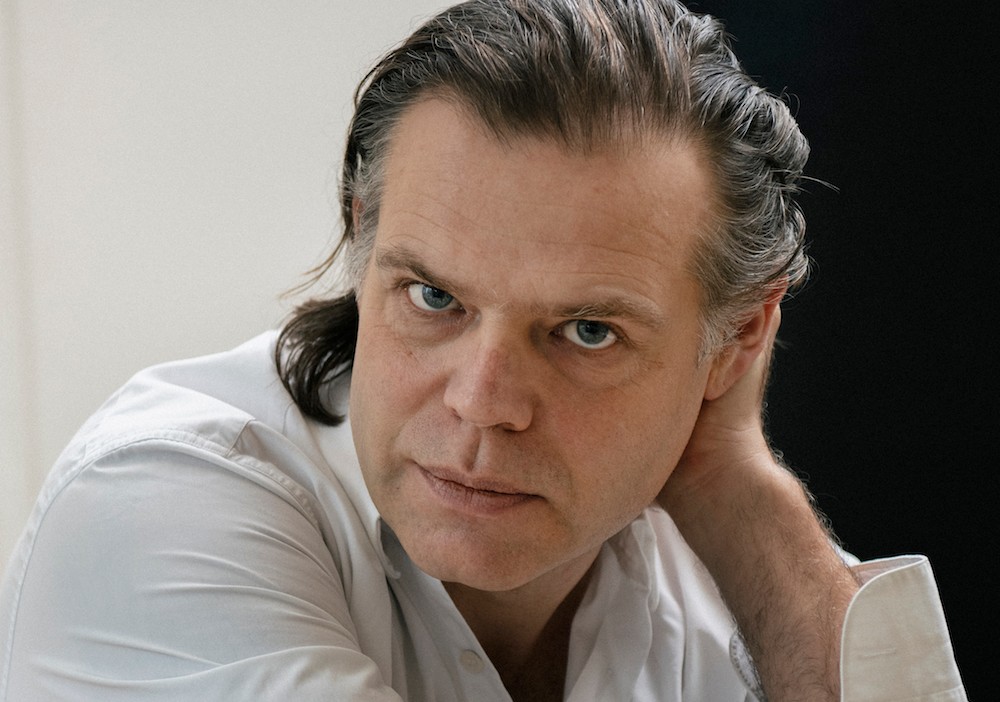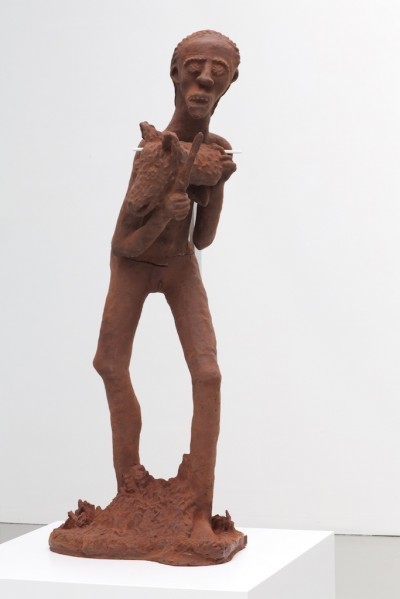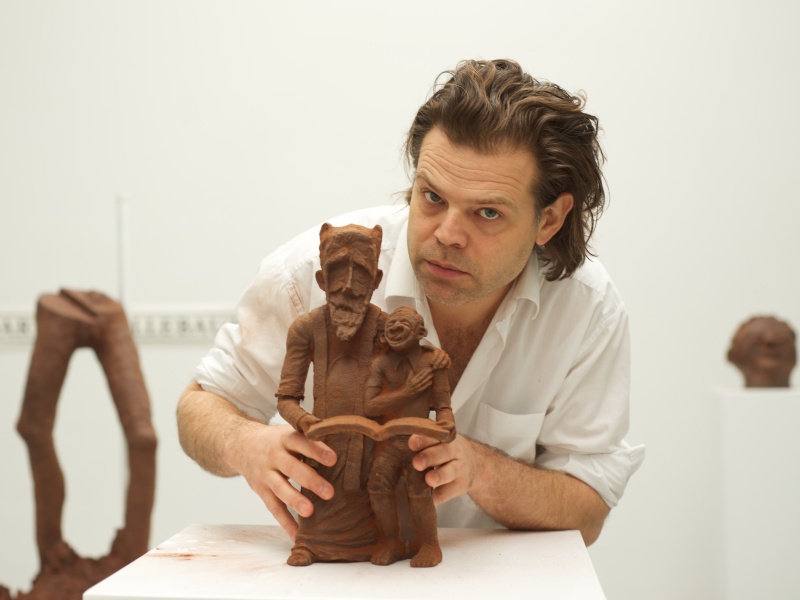

Renzo Martens (1973, Terneuzen) is een Nederlandse kunstenaar en filmmaker, die woont en werkt in Amsterdam en Kinshasa. Martens profileerde zich als controversiële documentairemaker met Episode I (2003) en Episode III: Enjoy Poverty (2008). Sinds 2010 is Renzo Martens de artistieke leider van het Institute for Human Activities (IHA) dat een gentrificatieprogramma op een palmolie plantage in het Congolese regenwoud ontwikkelt.
Biografie
Renzo Martens studeerde Politieke wetenschappen aan de universiteit van Nijmegen en beeldende kunst aan de Koninklijke Academie voor Schone Kunsten van Gent en de Gerrit Rietveld Academie in Amsterdam. Nadien resideerde hij in 2010 aan het ISCP in New York. In 2013 was Renzo Martens een van de 16 deelnemers aan het Yale World Fellow Program, het signature leadership program van Yale University.
Momenteel werkt de kunstenaar aan een PhD in de kunsten aan de School of Arts in Gent. Hij gaf ook lezingen over kunst, economie en representatie aan: University College London, London School of Economics, Yale University, Goldsmiths (University of London), Städelschule Frankfurt, HEAD Genève, HISK en KASK in Gent.
Werk
Episode I
In de oorlogsgebieden van Tsjetsjenië gaat Renzo Martens op zoek naar zichzelf. Met de camera op zichzelf gericht, vraagt hij de Tsjetsjenen wat zij van hem vinden. Episode I vermengt footage van een oorlogsgebied met een persoonlijk (liefdes)verhaal van de kunstenaar.
Episode III: Enjoy Poverty
Deze film opende het Internationale Documentaire Filmfestival Amsterdam (IDFA) in 2009. Episode 3 is een studie omtrent de politieke stellingnames van hedendaagse kunst en het resultaat van een twee jaar durende reis door Congo. In de film zet Martens een emancipatieprogramma op om lokale gemeenschappen te stimuleren om hun armoede te gelde te maken. De film werd o.a. getoond in Centre Pompidou, The Berlin Biennial, Manifesta 7, The Moscow Biennial, Tate Modern, Stedelijk Museum Amsterdam, 19th Biennale of Sydney en verschillende prestigieuze filmfestivals.
Institute for Human Activities (IHA)
In 2010 richtte Martens het Institute for Human Activities (IHA) op. Het Instituut wil kunstproductie inzetten om de lokale economie op een palmolie plantage in gang te zetten, en tegelijkertijd kennis te genereren over de rol van kunst binnen economische structuren. Sinds 2014 werkt IHA samen met de coöperatie van plantagearbeiders Cercle d’Art des Travailleurs de Plantation Congolaise (CATPC), dat nieuwe ecologische initiatieven ontwikkelt middels op de productie van kunst. Binnen de kunstwereld organiseerde IHA reeds presentaties in SculptureCenter, New York; Walker Art Center, Minneapolis; Tate Modern, Londen; Stedelijk Museum, Amsterdam; Wiels, Brussel; Museo Reina Sofia, Madrid en de 7e Biënnale van Berlijn. Tegenlicht wijdde een uitzending aan dit project en de VPRO is bezig een film te maken.
The Repatriation of the White Cube
Op 21 april 2017 opende IHA samen met CATPC een White Cube op de plek van Unilevers eerste palmolieplantage, in Lusanga (het voormalige Leverville) in het Congolese regenwoud. Deze White Cube is ontworpen door OMA en fungeert als hoeksteen van het Lusanga International Research Centre for Art and Economic Inequality (LIRCAEI).Tijdens de opening discussieerden plantagearbeiders over de baten van een White Cube voor een plantage met filosoof Suhail Malik, curator Clémentine Deliss, curator Azu Nwagbogu, de president van CATPC René Ngongo, en de Indonesische vakbond van plantagearbeiders Serbundo. https://nl.wikipedia.org/wiki/Renzo_Martens
White Cube is de nieuwe, langverwachte film van kunstenaar en filmmaker Renzo Martens (Enjoy Poverty). De film toont de relatie tussen westerse kunstmusea en het geweld van het plantagesysteem. Veel musea zijn gebouwd met winst onttrokken aan plantages. In White Cube scheppen Congolese plantagearbeiders een nieuw precedent. Ze slagen erin het concept van de ‘white cube’ te gebruiken om hun land terug te kopen van internationale plantagebedrijven en het veilig te stellen voor toekomstige generaties. Een film van Renzo Martens • 2021 • Nederland • 76 min
Renzo martens – A new settlemen

This is a project about plantation workers from Congo who made sculptures out of chocolate, directed by Renzo Martens. Those people worked for Unilever many years, before another company took it over. They live at the plantation and the houses were built by Unilever. The houses are almost breaking apart and they still have to pay for the houses even the old people who can’t work anymore. To make it even worse they don’t get retirement fund. The idea behind the chocolate sculptures is that an artist can make art about poverty, but it would be fair if poor people can make art about their own stories and opinions and can make money form it, instead of a random artist. That is what this hole project is about. Renzo Martens directed the people and he turns the workers into artists. He is in the position to realize this project.
The main reason why this project is so good is because Renzo Martens is actually saying that there is really something wrong within art, that has critics on inequality in the world. In the Tate Modern were critical political exhibitions of artists like Ai Wei Wei. These exhibitions were sponsored by Unilever for a few years. At the end you could say that these exhibitions were sponsored by the plantation workers. This says a lot about the art world. It contributes to the inequality and should reflect on it as an art piece. In the opinion of Renzo Martens this makes an art piece wrong.
The context of this project is social and economic. With mold of the sculptures they get filled with Chocolate in Amsterdam where the biggest cacao fabric is located. People can buy this chocolate sculptures in the gallery Fons Welters. They will earn more money then Unilever ever have given to them. The goal is to sell at least 10.000 of these sculptures so they can live from it. They already raised 18.000 euros. Renzo Martens is planning to start an art center in the plantation. The goal is within 10 years the people in Congo can live there from the sculptures and the art center without his help.
Renzo Martens is creating a critical point on how critical art is being organized. If we make art about poverty of the plantation workers, they wont have the benefit of it. “The people in Congo can think critical about inequality in the world. We don’t have to do that for them. We are doing that because we can write and read but that doesn’t mean that they can’t do it ourselves.”
He is also creating gentrification in the old Unilever plantation by starting an art Centre where art can be fully independent from the world inequality. This project is participating in the world of citizen. Its improving their life’s and gives them an opportunity in a remote area to express themselves about inequality in the world trough the sculptures. They can achieve a big audience. The art center is a system of institution and this hole project is realized by the Institute for Human Activities which is located in Congo. Renzo Martens is still looking for a good structure where one part of the money is going to the Congolese artists and the other part to realize more projects for the community. He is looking for a model to create more profit to expand it in other plantations. This project creates with the sculptures a new images and stories from the Congolese people, new relationships with Renzo Martens and also with the art world.
The problem in this project is that one plantation area in Congo has been chosen to create an art center so that they can life from it. But what about other plantations? This project can be focused in more then just one area. The treat that could arise is that this area is becoming more prosperous than other areas.
Its hard to come up with a solution because this is a very smart strategic project which is reflecting on critical art and at the same time improving life of plantation workers. It would be better if this project reaches other areas and make them prosperous to. By realizing this project on the plantation area with direction of Renzo Martens, he can choose a leader from the area who can extend this idea or can create more ideas to enlarge the capitalism from the plantation area and workers. Renzo Martens can also start museums in different areas where only work from “poor” people will be exhibited. https://beyond-social.org/wiki/index.php/Renzo_martens_-_A_new_settlement

